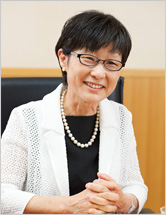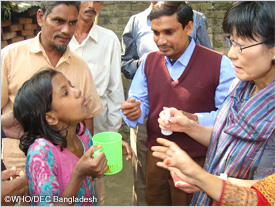February 20, 2015

Former Scientist, World Health Organization (WHO) Headquarters, Geneva
Dr. Kazuyo Ichimori
Dr. Ichimori was a scientist at WHO from 1992-2013. After working on control of filariasis, malaria, dengue and other vector-borne diseases at country and regional levels, she was appointed in charge of Integrated Vector Management, the Department of Control of Neglected Tropical Diseases at the WHO Headquarters in Geneva. From 2010, she was responsible for the Global Programme to Eliminate Lymphatic Filariasis in the same department. Her previous work with WHO has seen her involved in various initiatives to control and eliminate vector-borne diseases in Africa, Central and South America, and island nations in the Pacific.
Dr. Ichimori retired from WHO in 2013, and has been a visiting professor at Nagasaki University since 2014.
- *This interview was conducted in 2013 and reflects the conditions present at that time
Firsthand Experience Is the First Step in Eliminating Tropical Diseases
Although I am currently working at the World Health Organization (WHO) Headquarters in Geneva, I have worked as a scientist at WHO for over 20 years and in that time have been involved in various projects to eradicate tropical diseases, including mosquito-borne communicable diseases such as lymphatic filariasis and malaria. What has always struck me as particularly important when carrying out these initiatives is that we are able to see and experience local conditions firsthand. Actually setting foot in the areas where the disease is endemic affects us more directly on an emotional level and as a result we are often better able to get to the heart of the matter in terms of accomplishing the task at hand. WHO is currently supporting endemic countries to implement mass drug administration-based campaigns for entire endemic populations in 53 out of 73 countries where lymphatic filariasis remains, with the aim of interrupting transmission of this disease. Nevertheless, convincing 500 million people from a wide diversity of ethnic backgrounds, belief systems and cultures to consent to taking the medicine is no simple feat. It is only natural to have doubts when faced with the decision of whether or not to accept medication from a stranger. For an individual to be willing to take the medicine tends to rest heavily on whether the good intentions and sense of conviction on the part of the ones providing the medicine are adequately conveyed. Even then, to be able to feel at ease after taking the tablets, too, further depends on the establishment of mutual trust. It is being able to understand each other on this point that becomes so crucial for these projects to succeed. Ultimately, for people who may not be accustomed to the practice of taking medicine in their day-today lives, there is no other way than to appeal to their humanity. As people, I think, we all want to reduce the suffering in our lives as much as possible; no matter what the country or cultural background of the individual, I think that this is something to which we can all relate and that we all share as human beings In the Republic of Kiribati, an equatorial nation in the Pacific Ocean I remember asking a patient who had developed elephantiasis due to lymphatic filariasis if I could take his photograph for use in a disease education poster. Full of joy, he told me how happy he was that he, someone who was unable to walk unassisted and who was entirely dependent on those around him, might help somebody out there by having his picture taken. The experience reaffirmed my belief that no matter who we are, being able to contribute to others and play a meaningful role in our community offers us hope. The desire to rid our society of disease for the sake of the next generation, I think, is something universal.
Encouraging More Japanese to Openly and Proactively Show Their Support for Our Cause
In the late 1970s, Japan became one of the first countries in the world to successfully eliminate lymphatic filariasis. The worldwide program that continues to be implemented by the WHO today is the heritage of those initial seeds planted and nurtured by Japanese, including Japan's own success in eradicating the disease as evidence that the vision is indeed attainable and the country's ongoing support for numerous initiatives to eradicate communicable diseases ever since. Among these, the development and supply of reliable medicines play a vital role and I am delighted to think that Eisai, a Japanese pharmaceutical company, is providing DEC tablets toward eliminating this disease. I would love to see more industry–government–academia partnerships being established in Japan based on the initiative of Japanese and a more open show of support from groups and individuals in that country to better raise public awareness for this cause. Japan has played such a pioneering role in the planting of those seeds and I believe that now is the time for us to participate in what could be called the “harvest period” in terms of combating lymphatic filariasis worldwide. I urge all supporters in Japan to continue to actively participate in the program and play a greater role in harvesting the fruits of what is also our own labor as Japanese.
There are still many people suffering from lymphatic filariasis around the world, with an estimated more than 120 million people currently infected in emerging and developing countries. Japan possesses the technology to eliminate this disease and so it follows that we also share the responsibility to contribute. It was this belief that first led me to become involved in the fight against tropical diseases. I cannot imagine anything more wonderful than to be able to change the current situation to one where, in the next generation, people will be able to look at a photograph of a patient with elephantiasis and say, “So in the past, people had to go through life suffering from diseases like filariasis....”

[Notes to editors]
About Lymphatic Filariasis
Lymphatic filariasis is a parasitic disease that is transmitted to humans by the bite of a mosquito. Once transmitted, it causes lymphatic dysfunction. While infection is usually acquired during childhood, symptoms gradually appear over several years, with the most serious manifestations of the disease occurring in adulthood. The most serious manifestation, known as elephantiasis, is a permanent physical disability in which a patient's lower extremities swell to resemble those of an elephant. In addition to impacting a patient's ability to perform everyday tasks, it historically has led to many patients falling victim to social persecution due to biases against the disease. The disease also causes patients and their families much emotional distress. Nowadays, lymphatic filariasis affects an estimated 120 million people in 73 countries worldwide, most of whom live in developing and emerging nations in Africa and South East Asia. The disease has been proven to have existed in Japan since the Heian Period (794-1184). However, Japan succeeded in eliminating lymphatic filariasis in the late 1970s as a result of initiatives carried out by the government in partnership with the public-private sector and became the first country in the world to demonstrate the successful achievement of lymphatic filariasis elimination using DEC.
